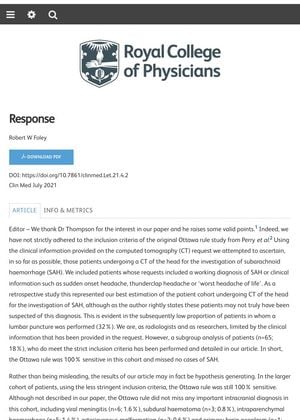Response
July 2021
in “
Clinical Medicine
”

TLDR The authors agree they didn't follow the original criteria strictly but found the Ottawa rule effective in all tested patients and suggest it might have wider use.
The authors of the paper responded to Dr. Thompson's critique, acknowledging that they did not strictly adhere to the original Ottawa rule study's inclusion criteria. They included patients undergoing a CT of the head for the investigation of subarachnoid haemorrhage (SAH) based on clinical information provided on the CT request. A subgroup analysis of patients (n=65; 18%) who met the strict inclusion criteria was performed, and the Ottawa rule was 100% sensitive in this cohort, missing no cases of SAH. In the larger cohort, the Ottawa rule was still 100% sensitive and did not miss any important intracranial diagnosis. The authors suggest that the Ottawa rule's scope may be wider than previously described and its clinical applicability may not be limited only to patients with a thunderclap headache. However, they caution that these results are hypothesis-generating and require validation in a prospective study. The study contributes to the growing body of evidence for the use of the Ottawa rule as a tool for risk stratification and facilitating discussions when requesting CT in patients with acute non-traumatic headache presenting to the emergency department.